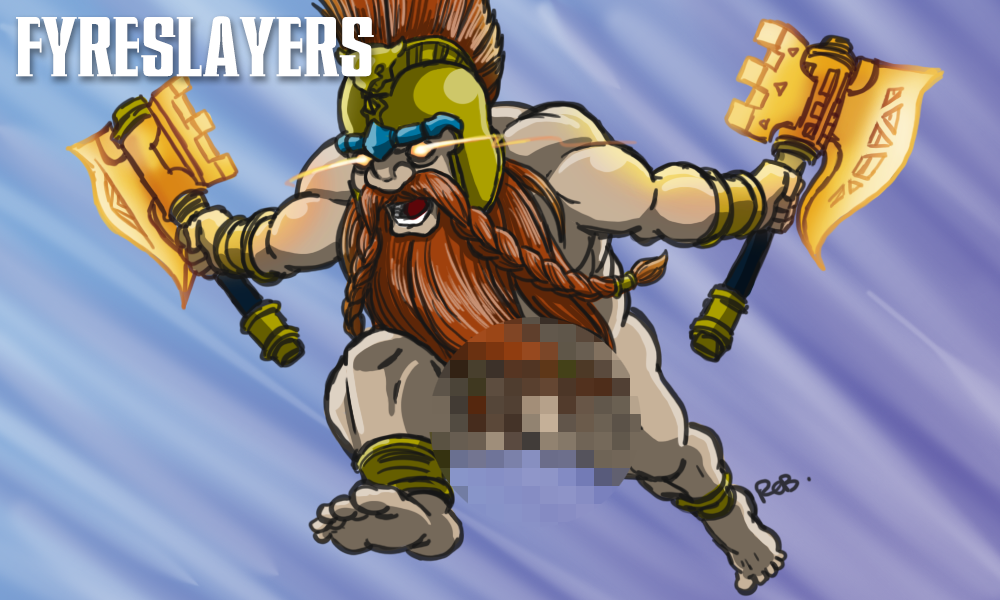Overview
Fyreslayers. And fire lizards (magmadroths). The half-naked duardin (dwarfs, dawi, whatever) of the Mortal Realms. At first glance these little guys might look frustratingly similar to each other on the tabletop, but we’re going to be looking at how each of the (yes, only 3) different units operates as well as the many (about 10) different heroes’ functions within the army.
For an army with so few options there’s a surprisingly varied way you can put together an army to suit a few different play styles.
First off, the faction only has a single universal battle trait: Ur-Gold Runes. There are 6 to choose from so you get enough for a game, and then some. At the start of each of your own hero phases you get to activate a rune (each one once per game) and then roll a dice. On a 1-5 your entire army receives the default effect until your next hero phase, while on a 6 they receive an Enhanced Effect. Don’t plan around the enhanced effect, just take it as a nice little bonus if and when you get it. For the most part these help you kill stuff better, giving you army-wide re-roll 1’s to hit, or extra Rend on your melee weapons, or 6’s to wound causing +1 damage with all attacks.
Across the board the army has a 4″ move characteristic, except for the Magmadroths which move 12″ (decreasing as they suffer wounds) but have a few tricks to get around the table. One of the Ur-Gold Runes you can activate gives +2″ move to all friendly Fyreslayer units so that will often be what you want to activate turn 1. Then there’s the Runesmiter’s and their magmic tunneling, but more on that later.
There are 4 different subfactions for you to choose form as well each of which changes your playstyle: Lofnir for more Magmadroths, Vostarg for more aggressive run-and-charge, Hermdar for even hardier, tougher to kill units, and then Greyfyrd for Hero-Hammer fans getting to take extra artefacts.
Overall, if you’re looking for a faction that can stand their ground, hit like a truck in combat, and gets really cool heroes on giant fire lizards then this is the faction for you.
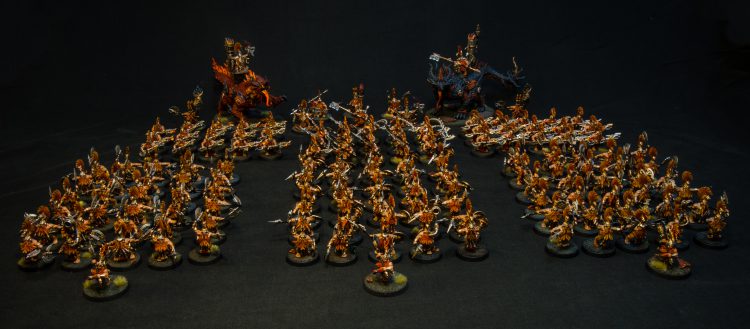
3.0 Changes
The new edition has brought a lot of changes to many factions, and we covered all of the specific changes from the FAQ that dropped day 1 in a separate article. I want to be clear that the changes and rules that will be talked about throughout are those that pertain to Matched Play games, as those are often considered the standard form of play, especially for pick-up games.
For returning players, one of the biggest changes to 3.0 matched play is the straight removal of Warscroll Battalions, and any 2.0 player will know that most lists hinged around the Lords of the Lodge battalion from the battletome. This seems much worse at first than it actually is when you remember that all armies lost access to their own Warscroll Battalions too.
Magmic Invocations have all changed quite a lot as well, soaring in points and each changing how they work, the biggest of which was the Fyrewall which no longer grants re-roll saves of 1 to nearby units, and no longer blocks line of sight at all. Now granting a Ward to one nearby Fyreslayer unit per phase (until the end of phase) and blocking off movement it is still useful, however much less protective against shooting armies than it was last edition.
With more command points than ever and new command abilities to use, some units now shine a little more than they might have before. On the flip side each Hero can only issue one command per phase and each unit only being able to be affected by one command per phase. Aura Command abilities are not limited in the same way, however, meaning that the Auric Runeson might see more play now for his command ability causing a 12″ aura for +1 to wound. One of the new abilities, Unleash Hell, used with a unit of Auric Hearthguard can be devastating against charging units, especially Monsters. The addition of Rally means being able to bring back models that were slain previously, making the very tough Hearthguard Berzerkers even harder to remove from the table.
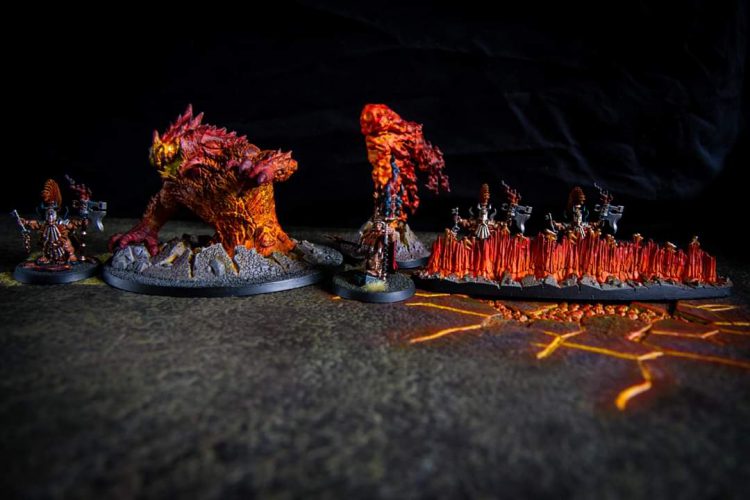
The Units
There are really only 13 different units in the book, and 6 of those are just the same hero either on or off a Magmadroth, all of which are worth looking at, but I’ll just be covering some of those that either now more worth considering than previous editions, or that are simply still auto-includes for most players and what you can expect to see across the table.
The Runefather on Magmadroth will be popular this edition, with the ability to take an Artefact granting a 5+ Ward, alongside both the Monstrous and Heroic actions, make this Hero harder to kill and hit much harder than ever before. At just under 300 points this comes in as one of the cheapest Monster Heroes in the game and worth every point.
Hearthguard Berzerkers are a very popular unit, becoming Battleline with a Runefather General. You can easily take a couple units of and have a 6+ Ward becoming a 4+ so long as there’s a friendly Fyreslayer Hero within 10″. Considering you’ll be taking numerous Heroes this is easy to keep in place, making them a very tough unit to shift that hit back with 2″ range weapons with 2 attacks each that are either damage 2 with rend (broadaxes) or cause 2 mortal wounds per 6 to hit (poleaxes). Both are good weapon choices, and will vary slightly in effectiveness depending what you’re hitting, but it’s worth noting that the Poleaxes won’t stack with the new generic Prayer that your Priests can take, Curse. I prefer the Broadaxes, not needing to rely on rolling 6’s to get damage output with reliable damage 2 is solid.
Battlesmiths are a must-take for most players, giving off an aura of +1 to save rolls, this boosts your largely 5+ save army to a 4+ save. They are also a Totem, and so can issue commands at a larger distance same as the General of your army, which is less handy for Fyreslayers generally unless your opponent has a rule to remove the unit leaders from your units (ie Gargants stuffing things in bags, among a few other rare abilities).
A unit that has really come into their own in the new edition are the Auric Hearthguard, the ranged weapon variant that can be built from the Hearthguard Berzerker boxset. These saw little use in previous editions, with their axe wielding counterparts being more popular, however with 2 shots each at 18″ range and slowing enemy movement down with each 6 rolled to hit they can be an interesting pick for some board control. For each 6 you roll to hit against an enemy that unit subtracts 1 from its movement characteristic until the end of the controlling player’s next turn. A unit of 10 puts out 21 shots so you’re averaging 3.5 6’s (so 3 or 4 depending how that roll goes) and being able to take a chunk of movement away from cavalry units can be very useful. It can’t bring the movement down below half its starting move though, so you can’t fire away at already slow units and make them stationary!
Lastly I want to touch on the Runesmiter that is not on a Magmadroth. This warscroll has seen minimal changes since its first incarnation. This hero is a Priest which is always useful, able to choose from 6 Zharrgrim Blessings available to the Fyreslayers which range from making an enemy unit suffer -1 to hit rolls, giving a friendly Fyreslayer unit +1 to their save, and allowing units of Berzerkers to run and charge. The prayer he comes with is great as well though, granting +1 to wound rolls to a Fyreslayer unit nearby. However, where this hero is really useful is his Magmic Tunneling ability. When deploying armies you can set this model up in reserve, and when you’d set up another unit (not a Magmadroth) then that unit can join the Runesmiter in reserve, and then be set up at the end of any movement phase more than 9″ away from all enemy units and so that the unit joining the Runesmiter is wholly within 12″ of him.

How to Play
There are a few ways to play Fyreslayers, but it still boils down to the same basics. Move to enemy, take objectives, hunker down, and kill whatever comes near.
What makes you want to play the army differently will mostly come from your choice of sub-faction, the most unique being Lofnir. When you choose this Lodge as your subfaction you are allowed to take 1 more Behemoth than normal in your list, and every Magmadroth you take is allowed a mount trait, not just one. You can even take the same one multiple times, however if you’re running multiple then it’ll be worth considering at least one with Ash-horn Ancient to give itself and any other Magmadroths within 6″ of it re-roll saves of 1. You’ll also be taking more Auric Hearthguard than usual to make use of the Lodge’s command ability, which picks out one enemy unit within 12″ of a Priest and grants all Auric Hearthguard that target it during that shooting phase gain +1 to hit and wound rolls, a great boost to hit on 3’s and wound on 2’s before any sort of negative modifiers.
The most common/popular of the other Lodges is likely to be Hermdar for boosted durability and dishing out attacks quicker. This Lodge’s main draw is the Command Trait for the General: all attacks that target a Fyreslayer unit wholly within 12″ suffer a -1 to wound rolls. This makes tough units like Hearthguard Berzerkers even tougher to take down. The Lodge’s ability grants immunity to Battleshock for units when wholly within the opponent’s territory as well as 12″ if an objective. AND the command ability is incredible as well, used by any of your Hermdar heroes on any unit of Vulkite or Hearthguard Berzerkers, granting that unit the strike-first ability (allowing them to fight before the normal order of choosing units to attack with). With the extra amount of CP you’ll have now, using this every Hero phase is simple and extraordinarily effective. Used in your own turn this means you’ll normally get to attack with 2 units before your opponent, and used in your opponent’s turn allowing you to attack before any enemy units do.
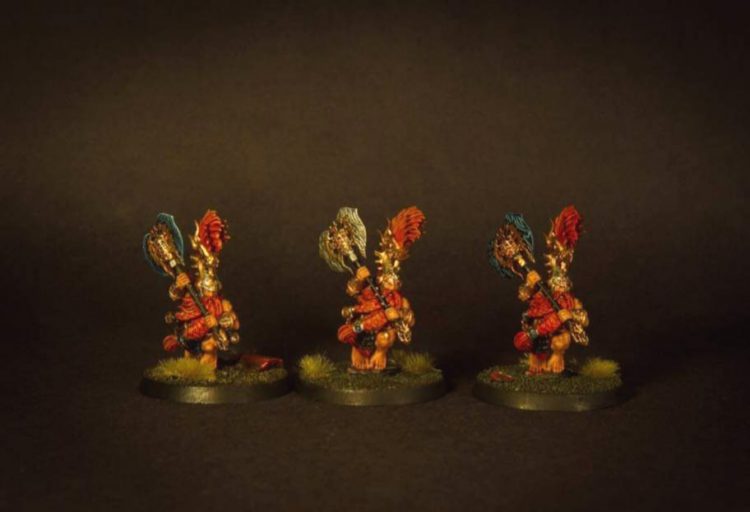
List Building
Now looking at those subfactions lets look at what a sample army list might look like. This is a 2,000 point matched play list, generated using the Warscroll Builder web app.
Allegiance: Fyreslayers
– Lodge: Hermdar
– Grand Strategy: Hold the Line
– Triumphs:
Leaders
Auric Runefather on Magmadroth (285) in Warlord
– General
– Command Trait: Warrior Indominate
– Artefact: Amulet of Destiny (Universal Artefact)
– Magmadroth Trait: Coal-heart Ancient
Auric Runesmiter on Magmadroth (275) in Warlord
– Runic Iron
– Artefact: Salamander Cloak
– Universal Prayer Scripture: Heal
Auric Runeson (80) in Warlord
– Ancestral War-axe
Auric Runesmiter (120) in Warlord
– Runic Iron
– Prayer: Searing Heat
Battlesmith (125) in Warlord
Auric Flamekeeper (80) in Warlord
– Artefact: Tyrant Slayer
Battleline
10 x Hearthguard Berzerkers (270) in Hunters of the Heartlands
– Broadaxes
– Reinforced x 1
10 x Hearthguard Berzerkers (270) in Hunters of the Heartlands
– Broadaxes
– Reinforced x 1
10 x Vulkite Berzerkers (170) in Warlord
– War-picks & Slingshields
Units
10 x Auric Hearthguard (240) in Warlord
– Reinforced x 1
Core Battalions
Hunters of the Heartlands
Warlord
Warlord
Additional Enhancements
Artefact
Artefact
Total: 1960 / 2000
Reinforced Units: 3 / 4
Allies: 0 / 400
Wounds: 128
This army uses a lot of the strategies and combinations mentioned above and uses a bit of everything that the army has to offer. Organising the army into Core Battalions, taking 2 Warlord Battalions grants 2 extra enhancements which I’ve chosen as extra artefacts to give both Magmadroths a Ward to help keep them alive longer. Then, with the Hearthguard Berserker units in Hunters of the Heartlands these units cannot be on the receiving end of any Monstrous Actions meaning they cannot be stomped on but more importantly they can always receive the Hermdar command to gain strike-first in the combat phase. The Auric Hearthguard are set up in reserve with the Runesmiter so that they can appear end of the movement phase turn 1 within shooting range of something that needs to be slowed down, or if you’re lucky enough, kill. The Flamekeeper is a cheap Hero that is taken for his ability and to fill out a Warlord Battalion, a 12″ wholly-within aura when your models die you count up to 6 and can unleash for a very powerful buff for a nearby unit; it’s not a command as well which means that units affected can still receive commands as well during the same phase so stacks with the Hermdar strike-first ability or All Out Attack/Defence.
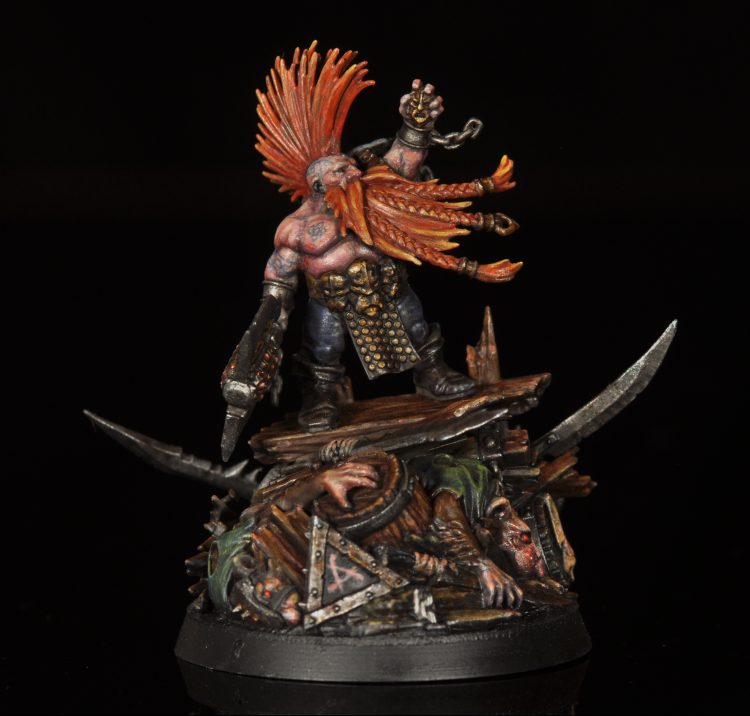
All in all, Fyreslayers are an army that strike a little slower with their shorter move, but can afford to get stuck in mid-field with some of the toughest and strongest units in the game and come out on top, hunkering down objectives and scoring points in a battle of attrition.
Any questions or comments? Let us know before or email us at contact@goonhammer.com.
